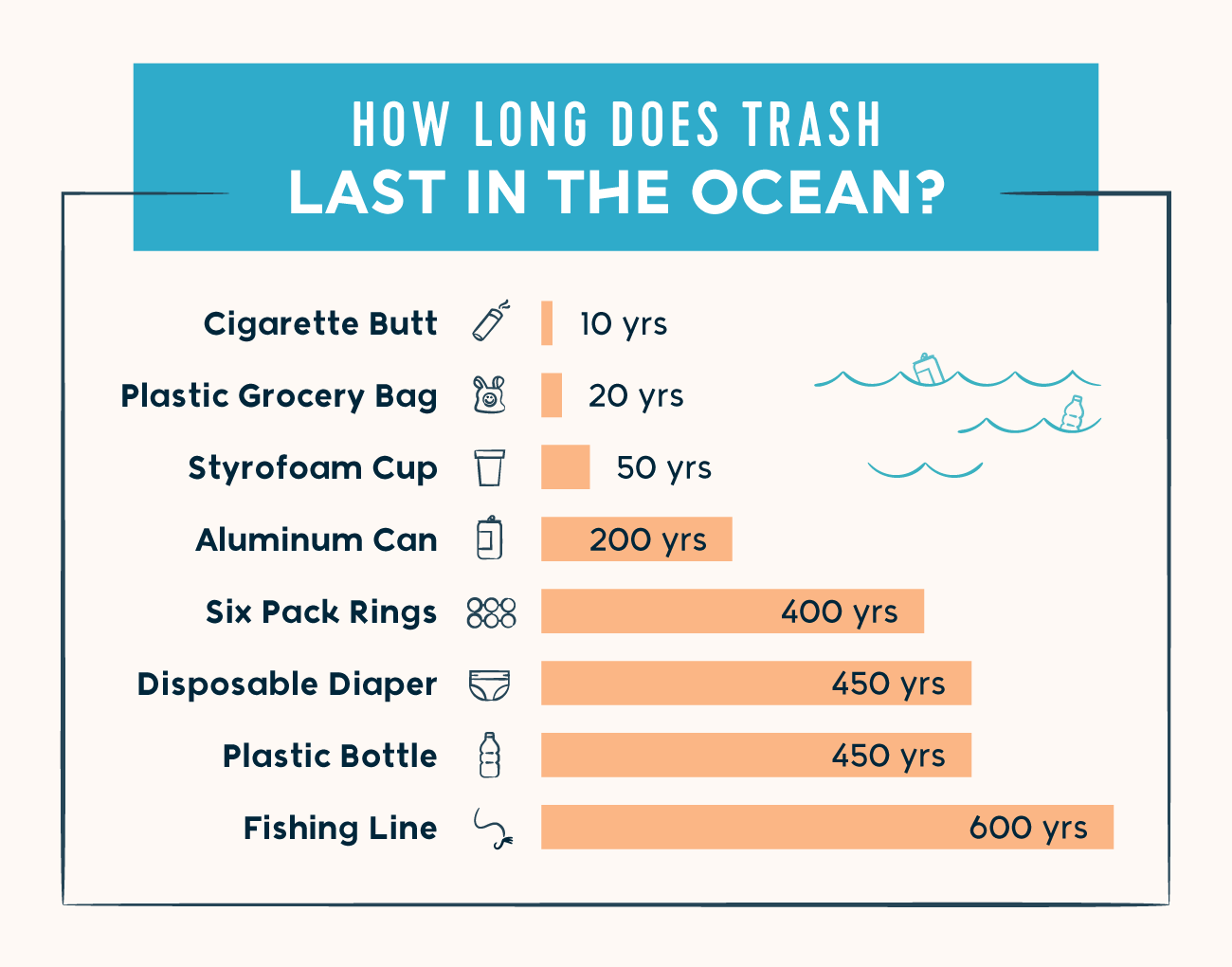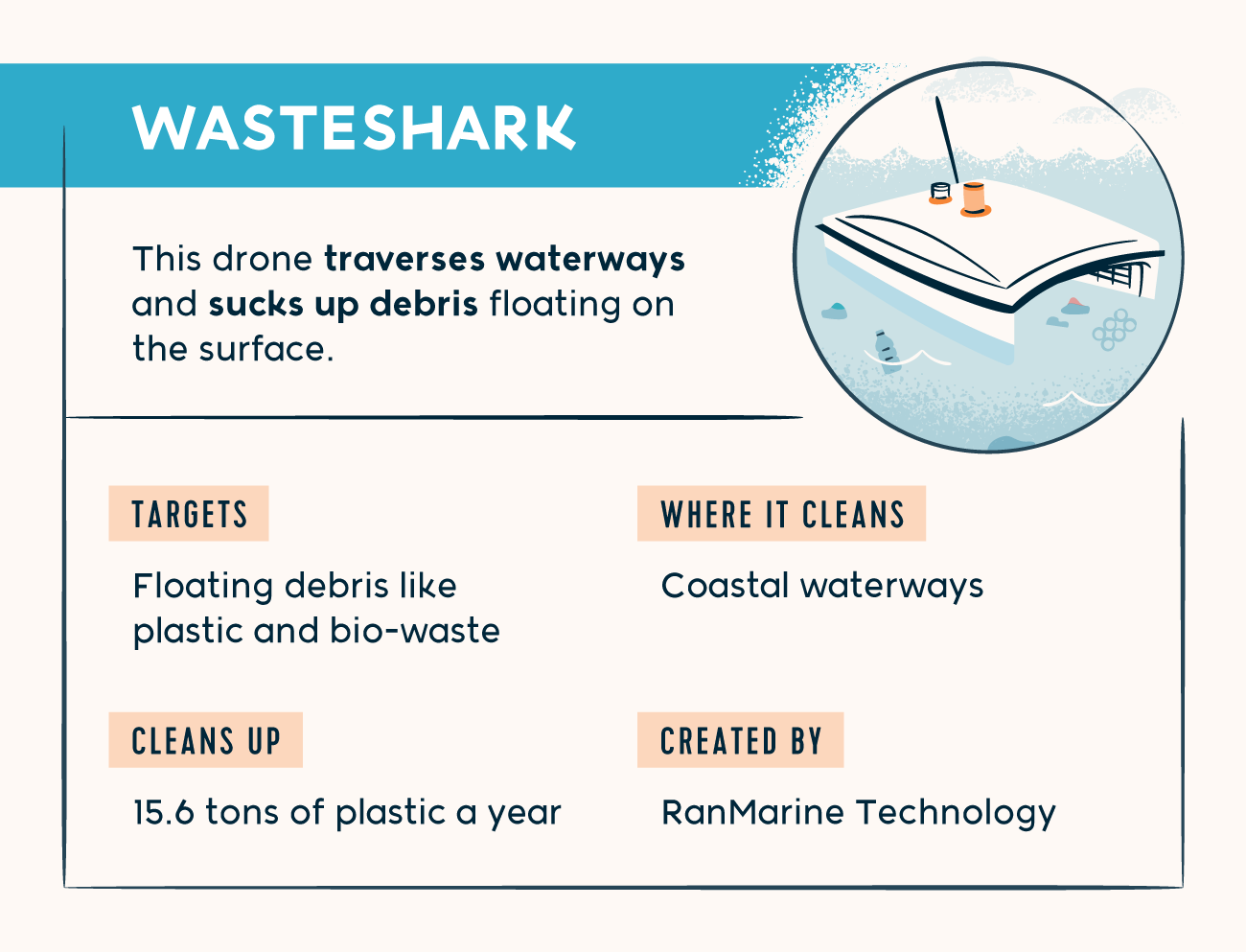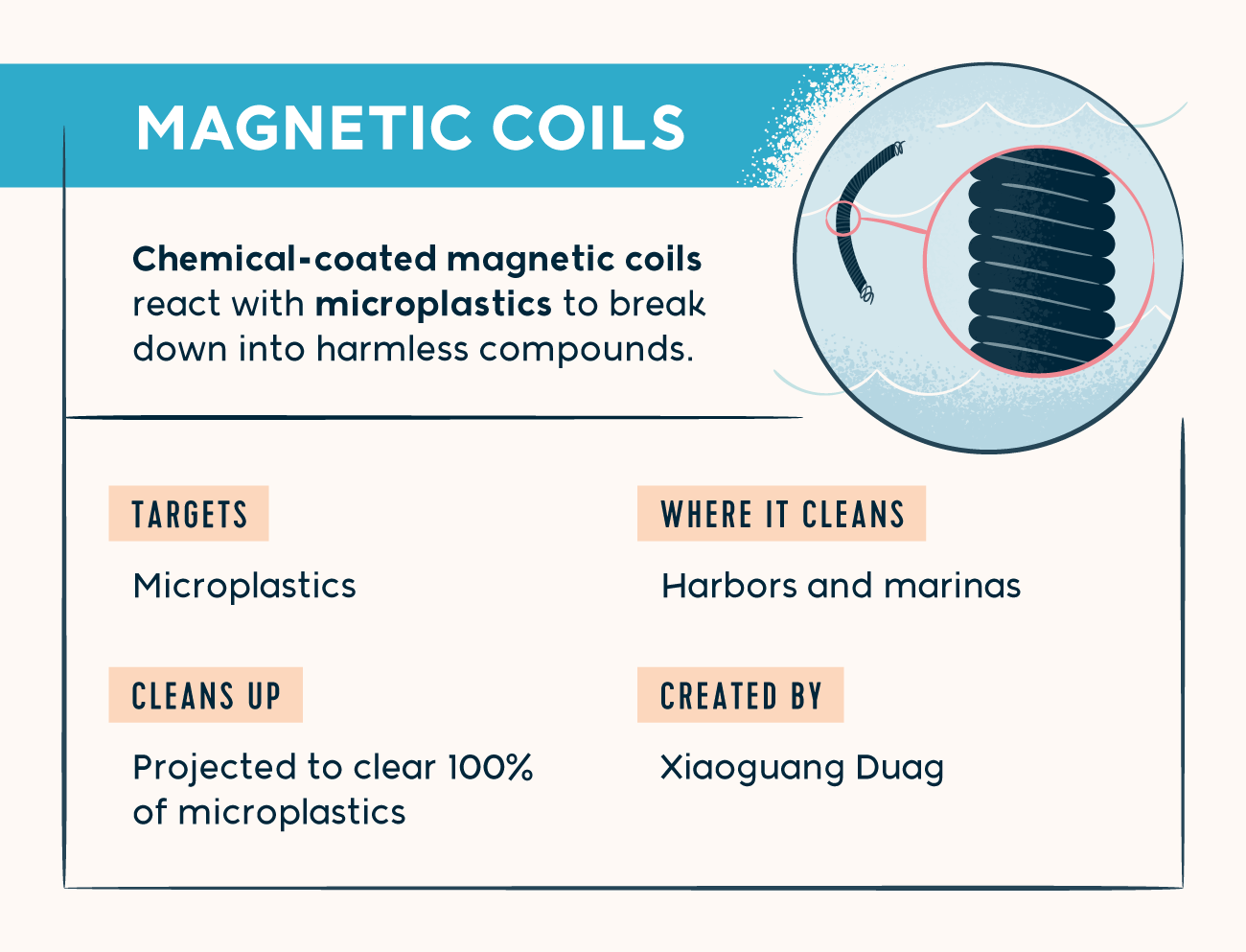Plastic plays a large role in our lives, from everyday products we purchase at the grocery store to the materials that build our cities.
However, plastic often ends up in the ocean, largely impacting marine ecosystems.
Each year, 8 million metric tons of plastics are found in the ocean, on top of 150 million metric tons that are currently being circulated in the water. Even more shocking, our oceans are projected to have more plastic fragments than fish by 2050.
This frightening amount of trash affects ocean life from seabirds to marine mammals. In fact, plastics have been found in more that 60 percent of all seabirds and in 100 percent of turtle species –– they mistake this trash for food and try to eat it, causing life-threatening problems.
How Long Does Trash Last in the Ocean?
Although plastic materials are very durable and efficient for manufacturers to produce, they’re causing a long-term problem for the oceans’ ecosystems. According to data from the National Oceanic and Atmospheric Administration (NOAA), this is how long it takes for man-made products to biodegrade in the ocean:

While there’s much work being done to find environmentally-friendly substitutes for plastics, the problem isn’t going away any time soon. Fortunately, scientists and inventors are working to build smart solutions to the growing problem of ocean pollution. Below, we highlight six high-tech innovations scientists have come up with to help clean ocean pollution.
1. System 001
Boyan Slat, CEO of The Ocean Cleanup, has invented a prototype that aims to target the gyre at the heart of the North Pacific Ocean. Also known as the Great Pacific Garbage Patch, this gyre is a concentration of trash located between Hawaii and California that’s about three times the size of France. This is the first system to be trialed and utilized in this area of the ocean.
The innovative design is a U-shaped boom-and-skirt array that floats with the currents to collect and contain ocean plastic from the gyres. This 62-mile long floating net has a passive and slow-moving design, so marine life remains unharmed. Once the system is full, a vessel will remove the collected plastics, similar to a garbage truck. This prototype’s goal is to capture plastics before they biodegrade into even more harmful microplastics.

2. Seabin V5
The Seabin V5 is an ocean cleanup technology from the Seabin Project, a startup founded by Australian surfers. The Seabin V5, made from recyclable materials, is essentially a floating trash can that is designed for marinas, ports, and other areas with calm water. This device operates like a floating vacuum — its rim lies under the surface and pumps water into a filter bag located inside the container. The water is then pumped back into the harbor, leaving debris and litter trapped inside the container.
Costing only $3 per day to run, the Seabin V5 captures floating debris, including microplastics and fibers. Another component that makes the Seabin V5 stand out is its ability to absorb harmful oils from the water. The bin is equipped with pads that can absorb detergents and petroleum-based surface oils that are found in many marinas.

3. WasteShark
On August 29, 2018, scientists at RanMarine Technology designed WasteShark, an aqua drone that aims to prevent and reduce marine pollution by eliminating debris before it enters the world’s oceans. Its design is inspired by the whale shark, a unique filter-feeding whale that consumes its food through a long, wide mouth.
Traversing the coast of the United Kingdom, WasteShark skims the surface of the water and hunts down floating debris via a pre-plotted GPS map or manual steering. This technology can last up to 16 hours and collect up to 400 pounds (200 liters) of trash in one trip. Additionally, WasteShark is able to send information on pH levels, salinity, dissolved oxygen, nitrate, and other water qualities back to a lab.
Furthering their efforts to protect the environment, the scientists have ensured that the WasteShark does not harm marine life and is visible to shipping traffic.

4. Mr. Trash Wheel
Mr. Trash Wheel, also known as the Inner Harbor Water Wheel, is a sustainably powered trash interceptor cleaning up the harbor of Baltimore. Using a mix of hydro and solar power, Mr. Trash Wheel pulls hundreds of tons of trash out of the water each year before it reaches the Atlantic Ocean. So far, it’s prevented about 1.6 million pounds of debris from entering the ocean!
This technology, created by Clearwater Mills, LLC., is a water wheel that is placed at the end of a river or stream. Trash is funneled into the interceptor by the river’s currents. A conveyor belt powered by solar panels collects the trash and takes it up to a contained floating barge. The conveyor belt moves very slowly so that any wildlife near the machine isn’t harmed or trapped. Once the trash reaches this barge, it’s incinerated and converted into electricity.
Additionally, Mr. Trash Wheel can also capture any oil slicks that may travel down the river and is strong enough to withstand storms.

5. FRED
Student interns from the University of San Diego, San Diego State University, UC San Diego, Point Loma Nazarene and local high schools have partnered with Clear Blue Sea, a San Diego non-profit organization, to reduce garbage in the Pacific Gyre. FRED, which stands for Floating Robot for Eliminating Debris, is an ocean-traveling robot that runs on renewable energy to clean up harmful floating debris from marine environments such as bays, rivers, and oceans.
This prototype is currently in phase two of a four-phase project and is set to be completed in 2023. It’s designed with flaps in front of the machine that collects debris and transports it to a collection bin via conveyor belt. Solar panels help the machine run and it’s steered by remote control. This fascinating project aims to collect bigger plastics before they turn into microplastics.
FRED also comes equipped with sensors to keep marine life away during operation and the machine moves at a slow speed so animals can easily swim away.

6. Magnetic Coils
According to a study by scientist Xiaoguang Duag, a possible solution to tackle the global plastic problem could be a new type of nanotechnology. Nano-tech is any technology that is smaller than half the width of a human hair. Duag and his team created tiny magnetic nano-coils that can be created to break down microplastics in the ocean through a chemical reaction.
These coil-shaped tubes are coated with nitrogen and a magnetic metal called manganese. This coating reacts to oxygen molecules which will, in turn, attack microplastics. Through this chemical reaction, the microplastics will turn into environmentally-friendly salt compounds, water, and carbon dioxide.
Although more testing needs to be done in order to implement these magnetic coils, it could be a big step towards solving the ocean plastic problem.


For example, avoid cosmetics made from marine life or eliminate your use of plastic straws that end up in the ocean. The next time you go shopping, consider choosing sustainable seafood or cut it out of your diet all together.
Although scientists are leading the way in tackling ocean pollution with these technologies, there are many simple ways you can help to keep the ocean clean. Some ways to do this include avoiding plastic products and ocean-harming products. Alternatives to everyday wares like sunscreen deemed safe for the ocean and glass straws can go a long way.
More ways you can help include demanding plastic-free alternatives in your communities and voting on ocean-related issues. You can also consider doing a service trip for your next vacation dedicated to cleaning up the ocean. Taking small steps like these can go a long way towards positively impacting marine life.
The next time you visit a beach destination, remember to be mindful of the ways you can help prevent ocean pollution. Always remove trash and leave the beach in better condition than how you found it.





